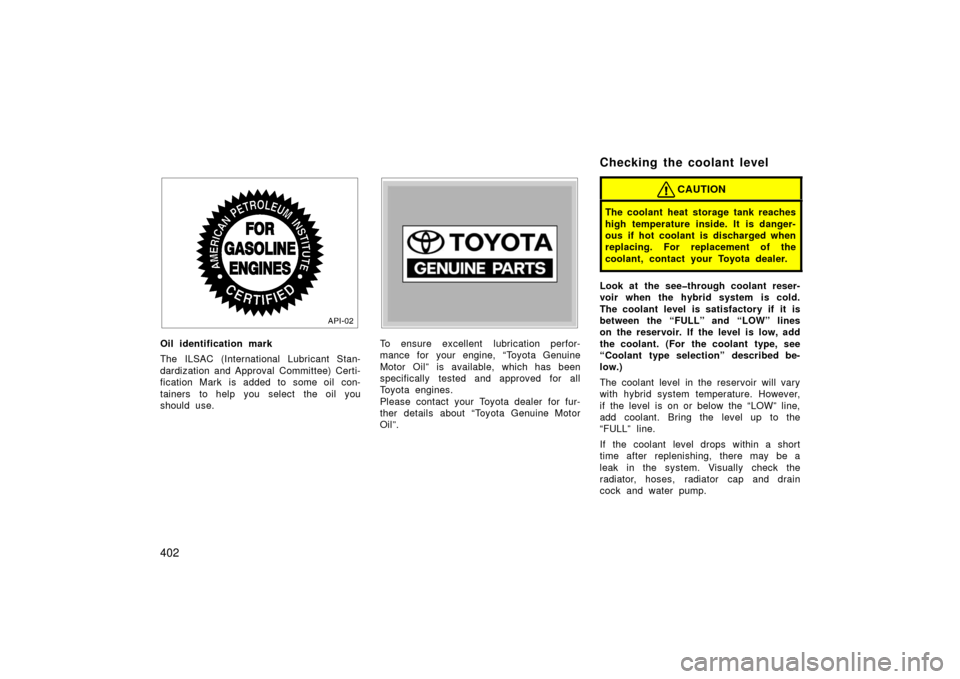Page 324 of 455

324
30p103
Electric water pumpCoolant heat storage
tank
Coolant flow control
valve
The coolant heat storage tank system
stores hot coolant and feeds it via the
electric water pump automatically to warm
the engine as required. This system helps
generate clean emissions. To confirm the
coolant heat storage system check, the
pump may operate automatically with the
vehicle stopped (in the “IG −OFF” mode).
Although the pump may operate and
cause noise while the vehicle is stopped,
this does not indicate a malfunction.
CAUTION
�The coolant in this tank is hot even
if the engine and radiator are cold.
�For replacement of the coolant,
contact your Toyota dealer.
�Do not touch bolts (9 pieces)
painted in yellow.
�In case the bolts are loosened,
there is a risk of hot coolant com-
ing out from inside the tank.
�When this has any malfunction, the
surface of this tank gets hot. To
prevent burning yourself, do not
touch the tank.
INFORMATION
�In such cases as the time of engine
starting and a short trip after the
engine is stopped, the electric water
pump will work for a moment, but
this is no problem.
�This is for the preparation for good
emission.
Your engine is fitted with iridium�tipped
spark plugs.
NOTICE
Use only iridium�tipped spark plugs.
Do not adjust gaps for engine perfor-
mance or smooth drivability.
Coolant heat storage system Iridium�tipped spark plugs
Page 402 of 455

402
Oil identification mark
The ILSAC (International Lubricant Stan-
dardization and Approval Committee) Certi-
fication Mark is added to some oil con-
tainers to help you select the oil you
should use.To ensure excellent lubrication perfor-
mance for your engine, “Toyota Genuine
Motor Oil” is available, which has been
specifically tested and approved for all
Toyota engines.
Please contact your Toyota dealer for fur-
ther details about “Toyota Genuine Motor
Oil”.
CAUTION
The coolant heat storage tank reaches
high temperature inside. It is danger-
ous if hot coolant is discharged when
replacing. For replacement of the
coolant, contact your Toyota dealer.
Look at the see�through coolant reser-
voir when the hybrid system is cold.
The coolant level is satisfactory if it is
between the “FULL” and “LOW” lines
on the reservoir. If the level is low, add
the coolant. (For the coolant type, see
“Coolant type selection” described be-
low.)
The coolant level in the reservoir will vary
with hybrid system temperature. However,
if the level is on or below the “LOW” line,
add coolant. Bring the level up to the
“FULL” line.
If the coolant level drops within a short
time after replenishing, there may be a
leak in the system. Visually check the
radiator, hoses, radiator cap and drain
cock and water pump.
Checking the coolant level
Page 406 of 455

406
Ti r e inf lat ion
pressure gauge
INSPECTION AND ADJUSTMENT
PROCEDURE 1. Remove the tire valve cap.
2. Press the tip of the tire inflation pressure gauge to the tire valve.
3. Read the pressure using the grad- uations of the gauge.
4. In case the tire inflation pressure
is not within the prescribed range,
insert the compressed air from the
valve. In case of applying too much
air, press the center of the valve
and release the air to adjust. 5. After completing the tire inflation
pressure measurement and adjust-
ment, apply soapy water to the
valve and check for leakage.
6. Install the tire valve cap.
If a gauge and air pump are not avail-
able, have your vehicle checked by
your Toyota dealer.
CAUTION
Be sure to reinstall the tire valve
caps. Without the valve caps, dirt
or moisture could get into the
valve core and cause air leakage.
If the caps have been lost, have
new ones put on as soon as pos-
sible.
Incorrect tire inflation pressure
may waste fuel, reduce the comfort
of driving, reduce tire life and
make your vehicle less safe to
drive.
If a tire frequently needs refilling,
have it checked by your Toyota deal-
er.
CAUTION
Keep your tires properly inflated.
Otherwise, the following condi-
tions may occur and cause an ac-
cident resulting in death or seri-
ous injuries.
Low tire pressure ( underinfla-
tion)—
� Excessive wear
� Uneven wear
� Poor handling
� Possibility of blowouts from an
overheated tire
� Poor sealing of the tire bead
� Wheel deformation and/or tire
separation
� A greater possibility of tire
damage from road hazards